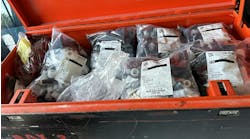Latest from Plumbing
Sponsored
By Jim Cika and Shawn Strausbaugh
When the city of Flint, Mich., switched its drinking water source in 2014 from Detroit to the nearby Flint River, its treatment plant did not sufficiently control the water’s corrosiveness. As a result, those conditions made the drinking water ripe for Legionella bacteria growth and likely contributed to two outbreaks of Legionnaires’ disease, according to a 2016 study by the Department of Civil and Environmental Engineering at Virginia Tech.
Corroded water pipes can help feed Legionella growth in a water or plumbing system. Corrosion can occur in system pipes, depending on disinfectants used, water temperature, pH levels and other factors, according to the Plumbing Manufacturers International (PMI) document, “Just the Facts: Legionella and Water Supply Systems.”
While disinfectants are necessary to treat water in plumbing systems, some of the best-known methods of disinfection, such as monochloramine and chlorine dioxide, can still lead to corrosion issues. Some water treatment programs can even increase corrosion rates in plumbing systems.
Research has shown that it takes a delicate balance to reduce opportunistic premise plumbing pathogens (OPPPs), like Legionella, in a plumbing system while avoiding excessive corrosion.
Disinfectants: finding the right balance
The type of disinfectant and concentration level used in a plumbing system can affect corrosion rates. Therefore, it is important to develop a solid testing and maintenance program that includes corrosion control before adding disinfectants to a system.
Attempting to prevent Legionella with certain treatment programs can sometimes create a more receptive environment for the bacteria. For example, super heating and chlorine dosing treatments have been shown to increase corrosion rates in some cases, said Cameron Manners, chief technology officer of business development at Aquam, during his recent presentation on “Legionella & Corrosion: Cleaning of a Complex Building Pipe System” at the 2018 NSF International Legionella Conference. He recommends inspecting a system with pressure cameras and conducting water tests to create a proper treatment program.
Research has shown that continuous chlorination can contribute to corrosion, which can eventually lead to leaks in plumbing systems. Janet Stout, president and director of Special Pathogens Laboratory, has completed extensive research on Legionella and has reported that hyperchlorination in hospital water distribution systems has been shown to be unreliable, inadequately penetrating biofilms in piping as well as corroding systems, ultimately leading to pinhole leaks and introducing carcinogens into the drinking water.
Other disinfection methods, including ultraviolet (UV) light disinfection, have shown promise in helping control Legionella at the point of entry in a system without causing corrosion issues. While UV disinfection does not change the pH or treated water quality, it does require supplemental controls to be placed in a system, explained Hodon Ryu, an environmental engineer and microbiologist with the EPA, during his presentation on “Technologies for Legionella Control in Premise Plumbing Systems” at the 2018 NSF International Legionella Conference. He also reported that new UV LED technology has significant potential for point-of-use application.
Additional research is needed to evaluate how disinfectants interact with water chemistry and piping materials in a premise plumbing system to better understand how these interactions may hinder removal of pathogens like Legionella.
Role of water temperature, pH levels
Corroded water pipes can provide an abundance of organic material to help Legionella bacteria survive and multiply. In addition, Legionella thrives in lukewarm water temperatures, usually in the range of 77°F to °F, according to PMI.
Corrosion is more likely to occur – and accelerate – at higher water temperatures. Rates of corrosion increase by a factor of three to four as the water temperature rises from 60°F to 140°F , according to the publication “Drinking Water Problems: Corrosion” published by Texas A&M AgriLife Extension Service. Above 140°F, the rate of corrosion doubles for every 20°F increase in water temperature. Reports on the water samples from Flint, Mich., revealed high temperatures and low chlorine levels. Those circumstances, along with iron stemming from corroding pipe, may have been major factors in enabling high Legionella levels there. Research has shown that iron is a crucial nutrient for Legionella in hot water systems and that it also reacts with and deactivates chlorine disinfectant.
Corrosion rates also can be affected by pH levels in water. The pH level is measured on a scale of one to 14 and shows how acidic or basic substances are. Water with pH levels below 7.0 are acidic, while water with pH values above 7.0 are basic. When acidic water is present, some metal pipes will corrode; they can lose their protective coatings, allowing iron to leach into the water. The Texas A&M AgriLife Extension Service also reported that moderately alkaline water (40 to 70 mg/L) with a pH between 7.0 and 8.2 is typically not corrosive. While water with a pH below 6.5 will be corrosive, especially if alkalinity is low, water with a pH above 7.5 also can be corrosive when alkalinity is low.
Methods of prevention
Because no single disinfectant treatment exists that will ensure permanent elimination of the bacteria, building owners and managers should conduct a full risk assessment of their water systems to develop a maintenance program that includes regular testing, monitoring and treatment for preventing Legionella outbreaks.
Testing should include checking water for the presence of Legionella bacteria and elevated levels of lead and iron. To stay on top of any corrosion issues, periodically monitor water chemistry and assess piping systems for corrosion levels. Monitoring also should be performed when disinfection methods are changed.
If contaminants or Legionella bacteria are found, take steps to sterilize pipes and/or prevent further corrosion. Some sterilization methods include flushing, point-of-use filtration, hyperchlorination and high temperature heating and flushing of the water distribution system. However, as referenced earlier, hyperchlorination may be unreliable and lead to increased corrosion.
The corrosion issues that likely led to Legionnaires’ disease outbreaks in Flint are a strong reminder of the crucial role systematic monitoring, testing and use of appropriate treatment techniques play in the fight against these potentially deadly bacteria.
To view PMI’s “Just the Facts: Legionella and Water Supply Systems,” visit the PMI website at https://www.safeplumbing.org/health-safety/legionella-and-water-supply-systems.
Jim Cika and Shawn Strausbaugh are both directors of plumbing, mechanical, fuel gas & swimming pools technical resources in the government relations department at the International Code Council, Inc., an allied member of PMI.


